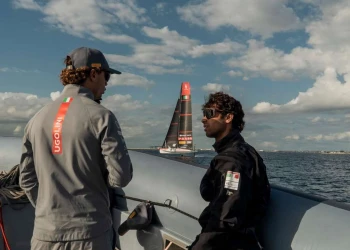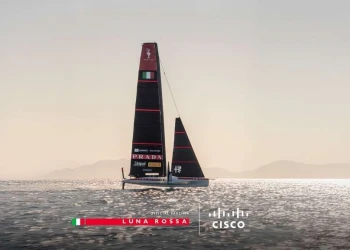
Inside the construction process
We tell you how Luna Rossa was built
Carbon fiber lamination is a delicate and complex technique. And it's not for everyone because, to succeed perfectly, it requires precise timing, flawless execution and highly experienced people. Like Julien Meunier, Construction Manager and Process Engineer, who covers the dual role of project manager and link between the design team and the construction team.
«My initial job is to develop the material databases so that the engineers who will have to design the structures are fully aware of the ones we will use for construction», he explains. «Then I make sure these materials match what has been tested, and finally, I provide the builders with guidelines».
So, on one hand, Meunier ensures that the construction process goes perfectly and on schedule, and on the other hand he verifies that the composite structure performs as designed. «Every single carbon part - whether produced in house or supplied - must match the design specifications exactly and be delivered on time, because the construction cycle has a schedule that cannot be changed, or else multiple departments will overlap».

The hull and deck are born from female (concave) molds - to achieve a near-perfect exterior finishing, that requires therefore a very small amount of filler (the mix of plaster and paint filler used to smooth the surface) and minimizes weight - and have a classic "sandwich" structure; this consists of a structural core (foam or honeycomb core cell, usually aluminium) "sandwiched" between several layers of epoxy resin-prepreg carbon skins. The process itself does not differ from the production of the most competitive racing boats: after layering a given number of sheets of carbon fiber, the mold is placed under vacuum to suck out excess resin. It is then finally "baked" in special ovens to catalyse perfectly. This cycle is repeated until the hull is perfectly executed and removed from its shell.
What makes the difference between Luna Rossa and a generic racing boat, or another AC75 boat, is hidden in the "secret" formula of the recipe: the type of carbon used, the material chosen to form the "core" (decided by the structural engineers during the design stage) and the correct application by the laminators are, in fact, top secret "ingredients." It is also very important to respect the execution times between steps, making sure, however, to be quick in working with fresh resin.
«If the lamination is not executed perfectly», explains Meunier, «not only do you risk delamination, but more importantly, you're almost certain the boat will not perform properly. It is enough to have even one single fiber not properly oriented to feel the difference in sailing, and sailors notice it right away».
Each part - with special focus on attachment points, which are reinforced (stays, running rigging, appendages...) – is individually tested before and after construction, and the same thing will be done with the finished hull. If this is not enough, the Quality Control Manager Stefano Beltrando performs CND tests (non-destructive testing) throughout the entire process, to monitor and report any inconsistencies, even minor ones.

Once extracted from the mold and complete in every part, the hull must be painted. With its innovative and visually striking graphics, the Luna Rossa prototype has fully captured the public's attention and the press spotlight. Not everyone knows, however, that this complex geometric livery was entirely hand painted. Mauro Zamichele, working with Valentino Melis and Danilo Sorrentino in the Luna Rossa Prada Pirelli paint department, created this little masterpiece and tells us how. «Once the lamination phase was finished», explains Zamichele, who is also part of the R&D team, «we prepared the hull by laying down a coat of high quality white primer (base); then we traced the guidelines with the laser, together with the various strips for the Luna Rossa and Prada names; then we dedicated ourselves to the graphics».
And this is the best part, because they had to reproduce a highly complex 2D drawing on a 3D surface.
«At that point we realized that the proportions would not be maintained and that the only viable option was to do the work entirely by hand», he continues. Of course, templates were used, but the various modifications had to be done individually and manually, especially to respect the symmetry between the left and right sides of the hull. «Once we realized that the triangles made logical sense», he continues, «the work became easier, and in the end it was really rewarding to see the finished hull; it was a team effort, and Danilo and Valentino did an awesome job».
At that point, another layer of paint was laid, «a very special and highly technological product used for boats that need to be 'light' and that don’t stay in the water for long but that require a perfect finish. Laying it down is not easy because we are at a point in the execution where it becomes difficult to correct any mistakes».
On America's Cup boats, where everything is taken to extremes for performance, paint also plays a crucial role. For this reason, at the end of each session at sea, Mauro and Valentino check the entire hull, focusing on the appendages (painted with yet another product), to ensure that there is not even the slightest imperfection: something as minor as a scratch or a bubble could create a turbulence that can affect the speed and quality of the "flight." The painting phase lasted about 10 days and followed a very specific schedule: «The painting department worked at night, alternating with technicians from other departments in order to avoid any interference and, at the same time, meet deadlines», Zamichele concludes.
Among these technicians are Marco Donati and Massimiliano Carbone, responsible for the electronics and hydraulics departments, respectively. The former, working with Davide Cannata and James Sweetman, explains the importance of his department: «Electronics is the heart of the boat», he says; «the way they are designed, the new America's Cup yachts don't move without batteries. Basically we prepare all the hardware, wiring and customization of products, communications systems, and other applications, both for the race boat and the support boats».

A large part of these systems is manufactured in house or customized by the team. «We build everything we can, to have control of the part from the most initial design stage», he continues, «and what we buy is still customized to match our needs and to be perfectly watertight». Industrial parts, in fact, are rarely meant to be used at sea at 50 knots, while the team needs them to function perfectly in extreme conditions. So they are customized to be waterproof, or encased in watertight boxes, designed and built in-house. «Eighty percent of the onboard systems are custom» says Donati. «Since the prototype was born to test a whole series of solutions, ironically it is more packed with systems, cables and control devices than the AC75, because we need to learn about them and see how they interact with each other before deciding which ones to translate to the official boat. The batteries are crucial, as they will activate the hydraulic systems that move the foils. Here again, it is necessary to use the latest technology available and then customize it and make it both waterproof and as light as possible».
But if these boats don’t move without batteries, boat handling and foils are virtually impossible without hydraulics... Hydraulic systems are essential on an AC75 explains Massimiliano Carbone, head of this department, where he works with Davide Pescuma.
«By hydraulics we refer to everything that is applied with an oleo dynamic force; instead of a mechanical force applied to the various utilities of the boat (ropes, etc.), you now have oil pressure that goes into linear actuators called cylinders, which in turn distribute it to the various utilities that activate the boat's functions». On board the AC75 there are three circuits (closed and separate): one moves the arms (Foil Cant System), which is one-design and therefore the same for all; then you have a circuit that moves the flight system (Foil Flap System) which determines the flight height with flaps and rudder; the third circuit moves the sails (Sail System). The latter two are "free" and therefore designed and developed by the team.
Specialized electronics and hydraulics technicians carry out continuous checks on the boat: before launching, during training and racing (from the support boats via monitors), and when returning to the dock, to make sure that all systems are adjusted as planned and working properly.






